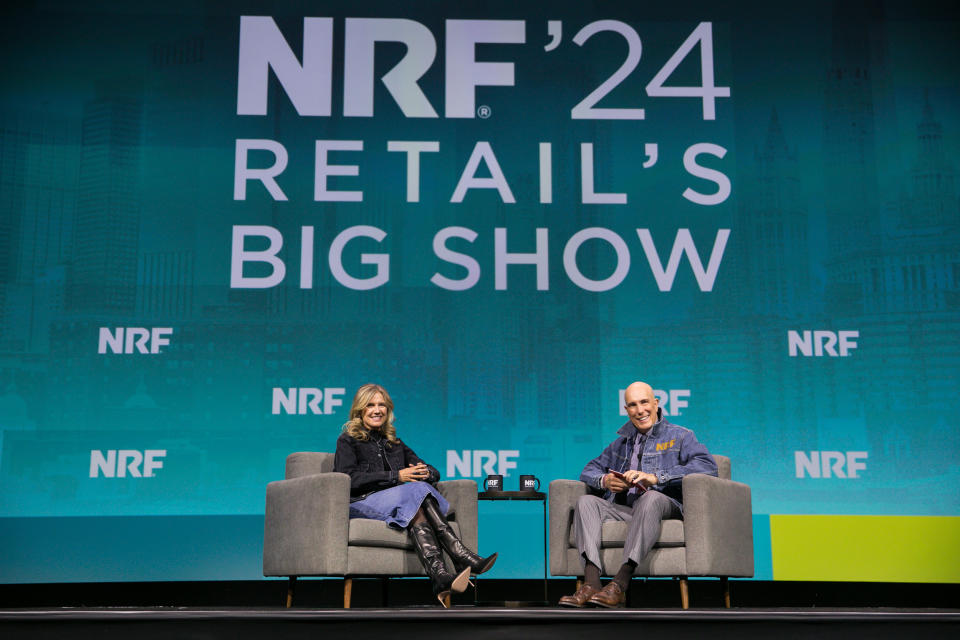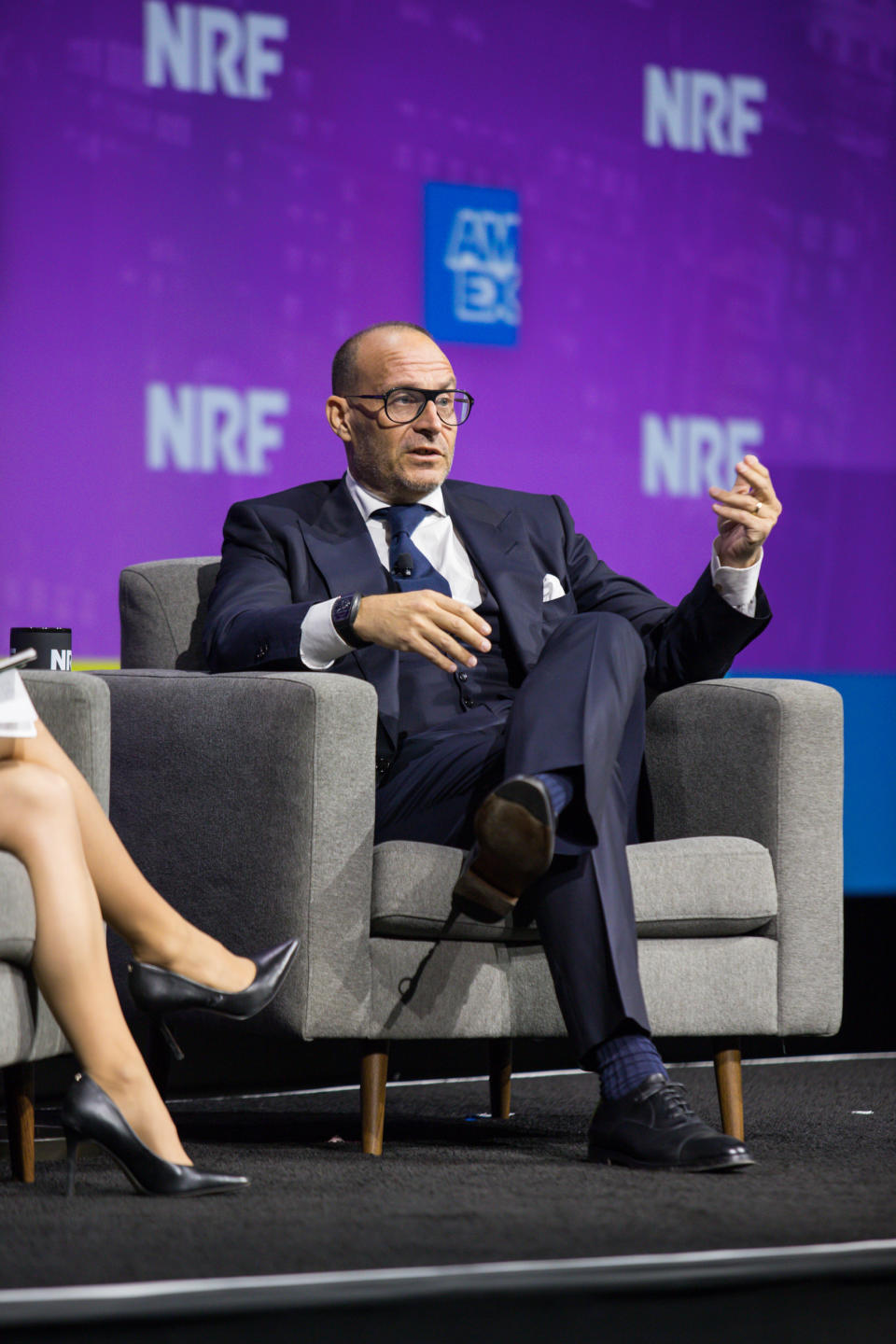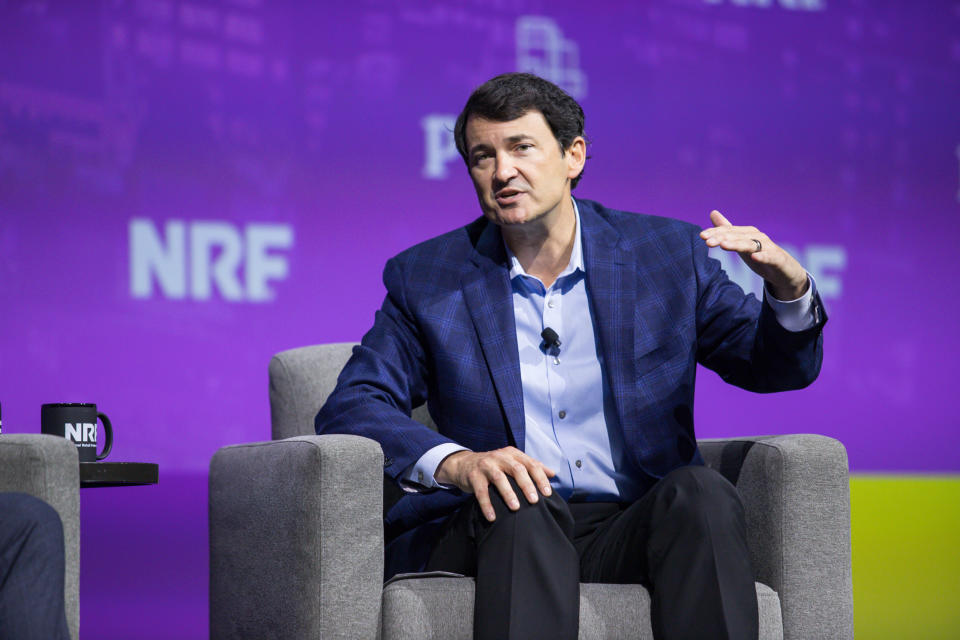NRF’s Big Show: The Mood, Issues and Outlook
- Oops!Something went wrong.Please try again later.

Compared to recent past NRF Big Show conventions, shrouded by COVID-19, uncertainties and store consolidation talk, this week’s edition had an overall feel-good vibe about the state of retailing and what lies ahead.
The crowd at New York’s Javits Center was huge — a record 40,000-plus — and there was a clear consensus among keynote speakers, panelists, industry analysts and economists that in the aftermath of the positive 2023 holiday season, characterized by about 3 percent sales gains on average, fourth-quarter profit reports for major retailers will get passing marks.
More from WWD
There was also a consensus that the U.S. economy will evade a recession, or at worst, have a soft landing, and that last year’s satisfactory level of spending will continue this year, if a bit under. Inflation is slowing. Certain categories of merchandise have actually lowered prices. The U.S. job market is expected to stay healthy. The Fed is expected to cut rates, and inventories are under control. And NRF-goers felt that all of that will spell a positive outlook for 2024.
“Last year retailers seemed hesitant about investing for growth because they didn’t know how they would manage through the economic headwinds, but they’ve made it through and now conversations have turned from controlling costs and restructurings to growth and building more stores.…That was a common theme I heard from many companies and a contrast from the past,” observed Kelly Pedersen, a partner at PwC, who spoke to chief executive officers, chief financial officers and NRF board members at the convention.
“There was a lot of energy,” at NRF’s Big Show, Pedersen said. “Retailers had a pretty good November and December and now they are predicting a decent first quarter.”
“People are optimistic,” said Steve Sadove, senior adviser to Mastercard and former Saks Inc. chairman and CEO. “There is an enormous amount of change and disruption occurring in the industry, as much as we saw post-recession with the growth of digital and omnichannel back then,” said Sadove. “There will be a burst of investment in all kinds of technology.” For the fourth quarter, Sadove predicted, “Margins will be fine. Earnings will come in as expected or better.”
“The retail business model has gotten much stronger,” said Brian Nagel, senior research analyst and managing director at Oppenheimer, during a panel on retailing and the economy with Ken Kim, KPMG senior economist, and Jack Kleinhenz, the NRF’s chief economist. “There’s been a normalization of promotional activity,” Nagel said. “Retailers are much smarter about it. They’re targeting promotions better. Retail profitability generally speaking should be quite good at this point….The biggest risk to spending is that we have a delayed affect from the rapid rise in interest rates.”
“There was a definitely a disconnect,” said Kim. “Consumers were shocked by how high inflation got. It was something consumers haven’t experienced in awhile and consumer sentiments and attitudes were soured, but that didn’t translate into lower spending. Companies were creating jobs and people were being hired.” He sees a pickup in the housing market this year with the Fed reducing rates.
Regarding the outlook for retail next year, Kleinhenz said he is “guardedly optimistic” and sees a small decline in spending from last year, but retailers are not headed into negative territory, he said. “It will be a slower economy, with slowing spending, but still positive….I don’t think higher balances on credit cards need be a concern. It’s not at the point where red lights are flashing.”
“Businesses are being built at a velocity we’ve never seen before,” said Harley Finkelstein, president of Shopify, who moderated a panel discussion with Beis Travel founder and chief brand officer Shay Mitchell and Glossier CEO Kyle Leahy.
The most discussed topics at NRF’s three-day Big Show, which concluded Tuesday, were:
Adopting the next generation of AI for personalization, allocation, data, targeted marketing, service and other customer-facing and back-of-house applications.
The resilience of consumers, and the disconnect between their attitudes and actions.
Shrink, and organized crime becoming a bigger component of it.
Innovating for convenience and for reducing friction and stress in the shopping experience.
Building new revenues through retail media, marketplaces and doubling down on loyal consumers.
Risks to retail: overseas conflicts impacting shipping, energy and commodity costs; failure to embrace change.
Water-cooler chatter revolved around a Saks-Neiman Marcus tie-up being held up by financing challenges, though the parties could be close to agreement on price, and whether there will be another bid for Macy’s Inc. following last month’s low-ball $5.8 billion buyout offer from an investor group including the real estate-minded Arkhouse and Brigade Capital Management. Macy’s has been quiet on that front.
There were also concerns expressed about the lack of fashion newness, and how the travel and restaurant sectors are booming at the expense of discretionary spending, and whether that reflects an enduring cultural shift or a temporary knee-jerk reaction by consumers eager to get out after being cooped up during the pandemic.
The popularity of resale was often cited, but questions loomed about the profit potential of the business model.
John Furner, president and CEO of Walmart U.S. and chairman of the NRF’s board, kicked off the conference by acknowledging some of the big challenges of the past year — including a rise in organized retail crime, “persistent inflation, high interest rates and global instability that only got worse.” But Furner’s message was one of retail resilience.
“We adapted to find new ways to serve our customers and help them stretch their budgets,” he said.
That ability to adapt is in keeping with some the best traditions of retail and, to back up the sentiment, Furner quoted Walmart founder Sam Walton, who said, “Everything around you is changing and to succeed, you must stay out in front of change.”

“I see nothing but possibility,” said Levi Strauss & Co. president Michelle Gass, who steps up to CEO later this month, in her session with Matthew Shay, president and CEO of the NRF.
Gass, former CEO of Kohl’s Corp. who earlier worked at Starbucks and Procter & Gamble Co., said she’s putting her brick-and-mortar and e-commerce expertise to work. “This moment is the culmination of everything I’ve done.” Gass plans to continue to push Levi’s ahead along familiar lines, growing in international markets and building more authority in categories beyond denim bottoms. “We should own the best woven button-down shirt for men,” she said. “That’s the perfect pairing to your pair of blue jeans. The power of the Levi’s brand, a drive to put the ‘consumer at the center of everything,’ the importance of innovation, Levi’s omnichannel retail positioning, and its values-based, purpose-driven orientation drove her to join the brand,” she said.

Saks CEO Marc Metrick, commenting on the reengineering of Saks Fifth Avenue into separate dot-com and stores companies, now considers the online business “the true center of gravity.” He also said there was no pushback from vendors on the separation: “It’s paid off.” He said Saks has almost 100 percent brand awareness in the U.S., and that even teens know the brand. “As far as targeting teens, we don’t. But our problem isn’t awareness. It’s a matter of consideration.”
He said he believes stores will always be part of the Saks brand. “We love our partnership with the SFA stores. It’s like you don’t stream ‘Hamilton’…you go to the theater to watch it. And that’s how I look at luxury. Luxury is always going to need a physical incarnation of what the brands are, so people can really understand and experience it. And then I look at the online channel as a way to express it and to obviously transact. And I think it’s a really, really strong interplay.”
On organized crime, Metrick, said, “It’s unbelievable. It’s affecting the consumer experience. When you go to CVS to buy deodorant, there’s plexiglass over it. We’ve had plexiglass over our experience online…we’ve had to put in a tremendous amount of fraud protection, so it’s affecting us.” Credits or claims about merchandise not received have more than doubled in the past couple of years, Metrick said.
For Ulta Beauty, the year ahead is all about innovation, which according to chief executive officer Dave Kimball is a core tenant of beauty that has led to the category’s success amidst economic downturn.
“In beauty, there is an insatiable appetite for discovering new products, new services, new experiences, new ways to explore the category and that happens across all ages and all demographics,” he said. “There’s such a demand for different ways to engage.”
With this desire for discovery, the retailer is focused on beauty technology — think AI-generated manicures and eyelash applications. For Kimball, new experiences keep the category fresh and the consumer engaged.
“When we think of beauty innovation, it has to start with how can we complement elevated high levels of human experiences,” Kimball said, emphasizing that combining tech with human experience will be key.
Earvin “Magic” Johnson, the All Star basketball player-turned-entrepreneur, spoke of how his lessons learned from sports can be applied to business. He engaged an overflow crowd with stories about how he was identified as a leader in high school when the principal asked him to stop kids from fighting and play nice, leading him to realize at a young age how he could be a leader off of the hardwood court as well as on it.
Currently, Magic Johnson Enterprises owns stakes in several sports teams, including the Washington Commanders and Los Angeles Dodgers, along with several restaurants, theaters and health clubs. He attributed his success to hard work — he gets up every day at 4:30 a.m., works out two hours and then heads to the office all day — and hiring people with “the same mindset, discipline and focus.”
He advised the businesspeople in the crowd to establish a three-year time frame to achieve their goals and find mentors to help them get there. “It’s hard to become number one, but it’s even harder to stay number one. I learned that in sports.”
Ed Stack, executive chairman of Dick’s Sporting Goods, outlined how he took the two-store business his father had established in upstate New York and built it into an 800-unit, publicly traded chain that is the largest omnichannel sports retailer in the U.S.
As the story goes, in 1948, 18-year-old Dick Stack had a dream of opening a bait and tackle shop and his grandmother opened the cookie jar and handed him $300 to make it a reality. Ed Stack worked in the family business starting at age 13. “I hated every minute of it,” he said because his friends were enjoying vacations and summer fun while he toiled away in the family business, but ultimately he embraced the opportunity.
Stack, who received NRF’s Visionary Award, said Dick’s road to success has been a series of ups and downs, including nearly going out of business from the 1987 savings and loan crisis, and in 1995 when it grew too quickly. “We got full of ourselves and made stupid decisions,” he said. But these stumbles can ultimately help make you better, he told the NRF. “You’ll learn more from your mistakes than your successes,” he said, adding that once you realize you’re on the wrong track, you need to stop and regroup immediately.
One controversial decision he made was to stop selling assault rifles and ammunition to people under 21. Although the move met with resistance, Stack said it’s up to business leaders to stand up for their convictions, make changes for the good of society and not listen to the naysayers.
Stephanie Linnartz, CEO of Under Armour, in conversation with one of the company’s brand ambassadors, Diamond Miller of the Minnesota Lynx of the WNBA, spoke about women in sports and Linnartz’s advocacy for female athletes — as well as all athletes.
Linnartz reiterated the sports brand’s mission to focus on innovation, performance, style and sustainability. From listening to female athletes who didn’t want white collars on their sports gear because they wear makeup, to using a yoga waistband on men’s football pants to eliminate “love handles,” Under Armour seeks to find ways to fulfill the needs of customers, she said. She also singled out the company’s development of a fiber to replace Spandex in clothing that is recyclable and efforts to improve fiber shed as other ways the company addresses consumer demand.
Kmart Australia, which has 325 stores in Australia and New Zealand selling home goods, kidswear and clothing, 85 percent of which is under its Anko private brand label, operates with the mantra “making everyday living brighter.”
“A lot of shopping is very stressful,” said Ian Bailey, managing director of Kmart Australia, explaining that much of the angst comes from consumers wondering whether a good price could be a better price later in hopes of a markdown. The Anko private brand offers, among other inexpensive items, toasters and kettles for 7.50 Australia dollars (U.S. $5).
Bailey said operating with the dominance of a single private brand “simplifies the selection, enables accelerated awareness of the brand and its products, and provides coordination across categories. The quality of the data when it’s around one brand is exceptional and very clear,” Bailey said. “We’re going global with our private brand” by wholesaling it to The Bay in Canada, and also developing toys with Mattel that will be available in the U.S. over the next 12 months. He’s also examining distribution opportunities in Southeast Asia and India with retailers there.
In a panel on the role of the CFO, Levi’s CFO Harmit Singh said the CFO’s role has broadened. “It’s about stakeholders,” meaning customers, employees as well as shareholders. “The new CFO has to embrace technology, ESG, growth.”
“The most important topic at Macy’s is growth. We’re investing more time in customer growth,” said Adrian Mitchell, Macy’s CFO and chief operating officer, who was also on the panel with Singh and Rothy’s president Dayna Quanbeck, who was recently promoted from CFO.
Mitchell said Macy’s is leaning into AI, by investing, learning and experimenting with it, citing such areas as pricing and markdowns and allocating products by location. “So many things are better done by computer so the team can focus on strategy, execution and problem solving,” Mitchell said.

CEO Hal Lawton of Tractor Supply, one of America’s hottest retailers, focused on the company’s growth, mentioning it recently topped $1 billion in e-commerce sales, as well as its use of AI for marketing copy, replenishment and customer service, including a “super personal shopper” that he said was indistinguishable from a human. He also cited Tractor Supply’s customer service platform called Gura, which scrapes web and training materials so associates can readily respond to questions from customers, including for product recommendations. Tractor Supply also uses AI to spot when checkout lines get long and when additional labor is needed right away.
Technologies that reduce friction in the shopping experience, provide conveniences and personalize the shopping experience were spotlighted at the Innovation Lab. Among the exhibitors was Sheeva.ai, a one-touch system at the gas stations where you just touch the app, select the gas and fill up you car, without requiring the use of a credit card, and Psykhe, a “personalization-as-a-service platform using deep learning and psychology” to target specific products to those most likely to purchase them. The Lab also put labor technologies front and center including Reflex, a system geared to optimize staffing at the right times, to help retailers find associates and save money through better scheduling.
“We are in a new moment in AI — it’s been going on for decades but generative AI is definitely new,” said Salesforce CEO Marc Benioff.
On another positive note, the ninth annual NRF Foundation Honors dinner Sunday night at the New York Marriott Marquis drew 800 attendees and raised more than $3 million for student scholarships and career development programs. Stack received The Visionary 2024 Award, and the evening recognized those “shaping retail’s future” including Lululemon chief information officer and executive vice president Julie Averill; Crocs senior vice president and chief marketing officer Heidi Cooley; The Kroger Co.’s senior vice president and CIO Yael Cosset; Shopify’s Harley Finkelstein; Snoopslimes founder and CEO Jungmin Kang, and Burlington Stores’ senior vice president of leadership and organizational development, DEI and community impact Mecca Mitchell.
— With contributions from Evan Clark, Jean E. Palmieri and Emily Burns
Best of WWD

